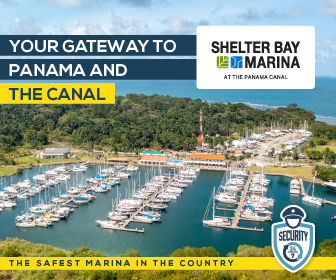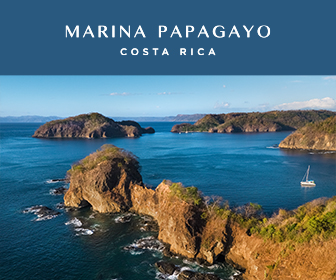Sailing Advisory Panama to Galapagos
Information for yachts sailing from Panama to the Galapagos Islands (Archipelago de Colon): Area Eastern Tropical Pacific: Equator to 9 North and Pacific Coasts of Panama/Colombia/Ecuador to 92 West, including Golfo de Panama. Galapagos Islands 845 Nautical Miles from Panama.
Published 8 years ago, updated 5 years ago
Yachts sailing from Panama to Galapagos, or to mainland Ecuador, have to pass the Intertropical Convergence Zone (ITCZ) on this voyage. The ITCZ is an area of disturbed unsettled weather surrounding the earth a few degrees north of the Equator where the northeast and southeast Tradewinds converge and where the sea temperatures reach their maximum.
It is an area with moderate to strong convection interspersed with areas of calm (the doldrums). There is frequent torrential rain with thunder and lightning and often squally with winds from all directions. In the area between Panama and Galapagos, the ITCZ generally moves north and south around 5 degrees North and the area is about 3 Degrees wide. Constant movements and change of coordinates for the ITCZ should be anticipated, which at times can be up to several degrees even within a 24 hour period.
Yachts leaving Panama should proceed towards Isla Malpelo (0359 N & 8136 W) as the first waypoint.
Leaving Panama, north of the ITCZ the wind will generally be from the north or northeast, light to moderate, until reaching the ITCZ. A course directly towards the Galapagos can be maintained as long as you stay north of the ITCZ, even after passing Isla Malpelo, depending on the location of the Zone. Just south of the ITCZ the wind will often be from the southwest, light to moderate, and yachts should continue on a southerly course until the wind shifts more towards the south and eventually to the southeast catching the Southeast Trade Wind, which normally happens around the Equator. At that time, yachts bound for the Galapagos can hold a westerly course directly to the Galapagos. Yachts bound for mainland Ecuador normally will be able to steer directly towards their destination after Isla Malpelo.
The wind will shift in the area south of the ITCZ depending on the location of the Zone and the Marine Weather Fax Charts published by NOAA/NWS several times a day show the coordinates for the ITCZ. Due to the often southwesterly winds south of the ITCZ, that part of the Zone is also frequently referred to as a “MONSOON TROUGH” in the eastern Pacific.
Due to the ITCZ, yachts should calculate a fair amount of motor sailing on this passage.
The prevailing Ocean Current is the Humboldt Current (also called the Peru Current) becoming the Equatorial Current towards the west. The Humboldt Current comes north along Peru’s coast and turns towards the northwest and west around the Galapagos and is present both north and south of the Islands. North and east of the Humboldt Current, in the area between Panama and the Galapagos, a countercurrent coming from the west and going southwards can also be experienced.
NOTES:
1) Yachts leaving Balboa, Panama directly towards Isla Mapelo, without calling at Islas Perlas, should keep well clear of Punta Mala in the western part of Golfo de Panama. The area around Punta Mala is known for some adverse weather conditions.
2) Yachts should also keep well clear of the coastal area near the Panama/Colombia border, as well as the Pacific coast of Colombia in general. Reports have been received covering piracy activity in the border area, and whilst there have not been any reports recently from the Pacific coast of Colombia, the area must be considered unsafe.
3) On Isla Malpelo there is a Colombian Navy Station. It is required that passing vessels, inclusive of yachts, call to the Navy on VHF Channel 16 reporting their position if they are within 20 Nautical Miles of the Island.
4) Yachts enroute are likely to meet small fishing vessels far offshore from the Colombian and Ecuadorian coasts. They are often approaching yachts to warn them of their nets or to do some trading, and no problems have been reported. Also close to the northern coast of Ecuador yachts have reported large areas with poorly marked floating nets.
5) Piracy:
Some infrequent Piracy Activity reported in the area, in 2004 a yacht was attacked en route from Panama to the Galapagos and during the past years several yachts have reported being pursued by suspicious crafts but escaped. Last year an attack was reported close to the northern coast of Ecuador. Prudent measures for a safe transit should be taken.
6) Weather:
Marine Weather Fax Charts covering eastern tropical Pacific from NOAA/NWS via US Coast Guard Stations at New Orleans, La. Honolulu, Hawaii Pt. Reyes, Ca.
Schedule and Charts also available on NOAA/NWS WebSite:
Marine RadioFax Charts
High Seas Text forecasts from NOAA/NWS WebSite:
Passage Weather: www.passageweather.com
Global Sailing Weather: http://globalsailingweather.com/index.php
Marine Weather on Line: Central America
GMDSS Marine Weather forecasts (METAREA XII) via Inmarsat or WebSite:
Earth and Space Research – OSCAR – Ocean Surface Current Analysis Realtime
Yacht Net: Panama Pacific Net at 14:00 UTC on 8.143 Mhz. USB (SSB)
Compiled by the late Karsten Staffeldt, Panama City, Panama R.P. January 2009 and last updated February 2016.
Sources: Cruising Guides – Monitoring Marine Weather information and forecasts for more than 10 years covering the area ; Contacts/Reports from yachts making the voyage Panama – Galapagos.
Related to the following Cruising Resources: Pacific Crossing, Routing








